
Enkapsulasi Probiotik Lactobacillus sp. Menggunakan Biopolimer Alginat dan Kitosan dengan Metode Satu Tahap

- Jurnal Nasional Terakreditasi
- Tazkia Nur Hidayah1, Djaenudin, Novriyanti Lubis
- Serambi Engineering, Volume VI, No. 2, April 2021 Hal. 1814-1824 p-ISSN : 2528-3561 e-ISSN : 2541-1934
Abstrak
Abstract
Lactobacillus sp are gram-positive bacteria that cannot survive in acidic conditions, such as stomach
acid conditions (pH 1.5- pH 2.5) so that a carrier is needed so that Lactobacillus sp can survive when
colonizing the intestine. One way to protect Lactobacillus sp in acidic conditions is by encapsulation.
The core material used for Lactobacillus encapsulation uses a mixture of Na-alginate and chitosan.
The mixture formed then becomes microcapsules using an electrospinning device. One of the
components of the electrospinning device is a syringe that provides pressure to form droplets that fall
into a solution of CaCl2 and chitosan with a concentration of 1.2%; 1.6% and 2%. Lactobacillus sp.
The encapsulated viability was tested for viability in simulated gastric acid (0.2% NaCl pH 1.2 and
pH 3) for 1 minute, 60 minutes, and 120 minutes using the Total Plate Count (TPC) method. After the
viability test was carried out, it was found that Lactobacillus sp. encapsulation results with a 2%
chitosan matrix with the number of colonies in the simulated gastric acid pH 3 for 1 minute is 4x109
cfu / g, for 60 minutes 3x109 cfu / g and for 120 minutes is 1x9 cfu /g.
Keywords: encapsulation, chitosan, lactobacillus sp., Na-Alginate, electrospinning
Lihat Dokumen
